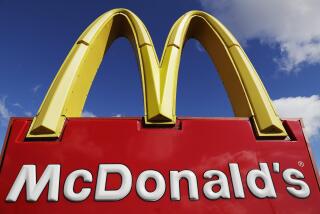Guides to Healthful Fast Food Eating : Popular Eateries Are Offering Nutritional Data on Meals
- Share via
Fast-food eateries are now offering nutrition booklets, but the largest group of nutrition professionals say healthy fast-food eating requires meatier information.
“For the 48 million Americans who eat meals on-the-run each day, just knowing ingredients in fast food is not enough,” said Anita Owen, registered dietitian and president of the 55,000-member American Dietetic Assn. “The key to nutritious fast food eating lies in rounding out your diet the rest of the day, because fast foods generally are high in calories, fat and sodium (salt),” she said.
Owen adds that registered dietitians do not classify foods as good or bad, but recommend a two-pronged nutritional approach--both at the restaurant and at home.
In addition to recognizing that salads, fruit juices and low-fat milk are nutritious food and beverage choices, Owen said consumers can make wiser fast-food selections by being aware that:
--Fried foods, such as chicken and fish, pies and fries, contain as much as 45% to 60% fat. No more than one-third of the day’s calories should come from fat.
--Foods and sandwiches served without condiments are lower in sodium. For example, one tablespoon of catsup contains about 150 milligrams sodium, and one tablespoon of mustard contains about 180 mg.--together nearly one-fifth of the total daily salt allotment. Experts recommend from 2,000 to 3,300 mg. of sodium daily--approximately one teaspoon of salt.
--One serving of mayonnaise-based topping, often found on hamburgers, can add more than 100 calories, most of which are from fat.
--Pizza topped with vegetables instead of meat is much lower in fat.
--You can special order fast food too. Many customers hold the pickle or hold the relish, but you may also want to hold the salt or hold the sauce. Be patient, though, as these orders may take an extra minute or two.
“The general rule of thumb is to eat a variety of foods from each of the four categories--dairy, bread/cereal, fruit/vegetable, and chicken/fish/meat,” Owen said.
She further advises that to compensate for fast-food eating, make sure the other meals you prepare are low in saturated fat, often found in shortening, meat drippings, salad dressing and butter. Cholesterol, found in dairy and meat products, should also be eaten in moderation, as should sugar. During the day eat fiber foods--fresh fruits, vegetables, bran and nuts--which are seldom found in fast-food eateries.
Dietitians recognize that fast food is a way of life today--working people often eat it because they only have time for a quick lunch; teens like it as an after-school snack; and parents want to take the family out for an affordable treat.
The group’s eating tips are intended to make fast food restaurants’ nutrition publications more meaningful to consumers. The booklets are or will soon be available in fast-food restaurants. New York, California and Texas are the first states to comply with the 1979 Food and Drug Administration and United States Department of Agriculture (USDA) ruling that requires product ingredient labeling on pre-packaged foods.
The American Dietetic Assn. is a professional organization whose goal is to promote the health of Americans through sound nutrition.
For further information on how to interpret fast-food nutrition booklets, contact a local registered dietitian or the association.
More to Read
Eat your way across L.A.
Get our weekly Tasting Notes newsletter for reviews, news and more.
You may occasionally receive promotional content from the Los Angeles Times.






